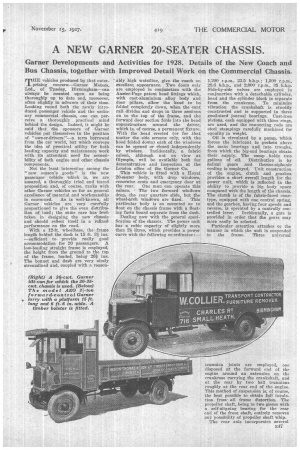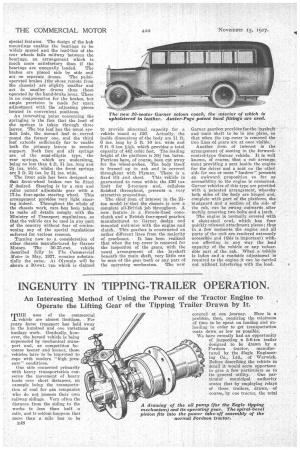• A NEW GARNER 20-SEATER CHASSIS.
Page 153

Page 154

If you've noticed an error in this article please click here to report it so we can fix it.
Garner Developments and Activities for 1928. Details of the New Coach and Bus Chassis, together With Improved Detail Work on the Commercial Chassis.
MHE vehicles produced by that enter1 prising concern—Garner Motors, Ltd., of Tyseley, Eirmingtam—can always be counted upon as being thoroughly op to date and, moreover, often slightly in advance of their time. Looking round both the newly introduced passenger vehicle and the ordinary commercial chassis, one can perceive a thoroughly practical mind behind the design. Indeed, it might be said that the sponsors of Garner vehicles put themselves in the position of "owner-drivers "—a term borrowed from the car world, but which conveys the idea of practical utility for both loading capacity and maintenance work with its attendant need for accessibility of both engine and other chassis components.
Not the least interesting among the "mew season's goods" is the new passenger vehicle which is, we are. assured, a thoroughly tried and tested proposition and, of course, ranks with other Garner vehicles so far as general excellence of material and workmanship is concerned. As is well-known, all Garner vehicles are very 'carefully proportioned to give the even cliOtribtv. tion of load; the game care has been taken in designing the new chassis and should reflect itself in a refined performance on the road.
With a 12-ft. wheelbase, the frame length behind the dash is 15 ft. 3+ ins. —sufficient to provide really good accommodation for 20 passengers. A low-loading straight frame is employed, the height from the ground to the top of the frame, loaded, being 261 ins. The bonnet and dash are very nicely streamlined and, coupled with a reason
ably high waistline, give the coach an excellent appearance. Two doors only are employed in conjunction with the Auster-Page patent head fittings which, with cast-aluminium alloy body and door pillars, allow the head to be folded completely down, when the cant rail divides and drops in three sections on to the top of the frame, and the forward door section folds into the head superstructure anound the driver, which is, of course, a permanent fixture. With the head erected (or for that matter the side screens only, with the hood folded down) each of the windows can be opened or closed independently by winders. Incidentally, a fabric saloon, although not on view at Olympia, will be available both for demonstration and inspection at the London office of the Garner Co.
This vehicle is fitted with a loyal 20-seater body, with drop windows, crosswise seats and emergency door at the rear. One man can operate this
saloon. The two forward windows drop, the rear quarters slide, but the wheeloarch windows are fixed. This particular body is so mounted as to float on the chassis frame with a floating facia board separate from the dash.
Dealing now with the general speeification of the chassis. The power unit has a cubic capacity of slightly more than 2+ litres, which provides a power curve with the following co-ordinates:—
1,200 r.p.m., 23.5 blop.; 1,500 r.p.m., 28.6 b.h.p., and 2,000 r.p.m., 35 b.h.p. Side-by-side valves are employed iii conjunction with a detachable cylinder, head and the cylinder block is separate from the crankcase. To minimize vibration the crankshaft is sturdily constructed and is supported in three good-sized journal bearings. Cast-iron pistons, each equipped with three rings, are used, and the connecting rods are steel stampings carefully machined for equality in weight. Oil is circulated by a pump, which' forces the lubricant to ,pockets above the main bearings and into troughs, from which the big-end bearings obtain their supply. The sump holds two gallons of oil. Distribution is by helical gears and thermo-siphonic cooling is employed. Unit construction of the engine, clutch and gearbox provides a short overall length for the power unit, which is reflected in the ability to provide a big body space compared with the length of the chassis. The clutch is of the fabric-faced conetype, equipped with one central spring, and the gearbox, having four speeds and reverse, is operated •by a centrally con trolled lever. Incidentally, a gate is provided in order that the gears may more easily be selected.
• Particular attention attaches to the manner in which the unit is suspended in the frame. Three universal
special features. The design of the hub mountings enables the bearings to be widely spaced and the load-line of the rear wheels falls midway between the bearings, an arrangement which is much more satiefactdry than if the bearings are unequally loaded. The brakes are placed side by side and act on separate drums. The pedaloperated brakes .(the shoes remote from the chassis) are slightly smaller and act in smaller, drums than those operated by the hand-brake lever. There is no compensation for the brakes, but ample provision is made for exact adjustment with •the adjusting pieces located in convenient positions.
• An interesting point concerning the springing is the fact that the load of the springs is taken through three leaves. The top leaf has the usual eyebolt hole, the second leaf is-. curved round the former one, and the third leaf extends sufficiently far to enable both the primary leaves to receive support. Both fore and aft springs are of the semi-elliptic type, the rear springs, which are underslung, being no less than 4 ft. 34 ins, long and 2i ins, wide, whilst the front springs are 3 ft. 2i ins. by 21 ins. wide.
Thu front axle has been designed so that front-wheel brakes can be fitted if -desired. Steering is by a cam and roller patent adjustable gear with a 17-in. foursepoke steering wheel. This arrangement provides very light steering indeed. Throughout the whole of the chassis work, care has been taken to make all details comply with the Ministry of Transport regulations, so that the vehicle can be used in any part of the country without fear of contravening any of the special regulations enforced for various reasons.
Turning DOW to a consideration of other chassis manufactured by Garner Motors. The 30-35-cwt. vehicle described fully in The Commercial Motor le May, 1927, remains substantially the same. At Olympia will be shown a 30-csivt. van which is claimed
to provide abnormal capacity for a
vehicle taxed at f.26. Actually, the inside dimensions of the body are 11 ft. 6 ins, long by 5 ft. 10 ins, wide and 6 ft. 6 ins, high, which provides a total capacity of 442 cubic feet. The loading height of the platform is 30i ins, laden. Portions have, of course, been cut away for the wheel-arches. The body itself is framed up in ash and is covered throughout with Piymax. There is a fixed tilt and sheet. This vehicle is guaranteed to come within the 126 tax limit for 2-tonners and, cellulose finished throughout, presents a very attractive proposition.
The chief item of interest in the 2iton model is' that the chassis is now a complete all-British job throughout. A new, feature is a Ferodo-lined coneclutch and a British four-speed gearbox manufactured to Garner design and mounted unit-wise with the engine land clutch. This gearbox is constructed on rather different lines from the majority
of gearboxes. It has been realized that when the top cover is removed for the inspection of the gears, with the usual arrangement of the leyshaft beneath the main shaft, very little can be seen of the gear teeth or any part of the operating mechanism. The new
Garner gearbox provides for the layshaft and main shaft to be in one plane, se that when the top cover is removed the two lines of gears are at once visible.
Another item of interest is the arrangement of seating in the forwardcontrol-type Garner vehicle. It is well known, of course, that a cab arrangement providing a seat beside the engine for the driver and a seat on the other side for one or more "loaders" presents, an awkward proposition so far as accessibility to the engine is concerned. Garner vehicles of this type are provided with a patented arrangement, whereby both sides of the body are hinged and, complete with part of the platform, the. 'mudguard and a section of the side of the cab, can be swung outwards after mefely removing two bolts and a latch.
The engine is normally covered with a sheet-steel cowl, which bag four quickly. released attachment pieces ; thus in a few momentsthe engine and all parts of the unit are rendered extremely accessible and (this is important) without affecting, in any way the load capacity of the vehicle or any vulnerable part of the cab. When, a vehicle is laden and a roadside adjustment is required to the engine it can be carried out without interfering with' the load.












































































































































































































































































